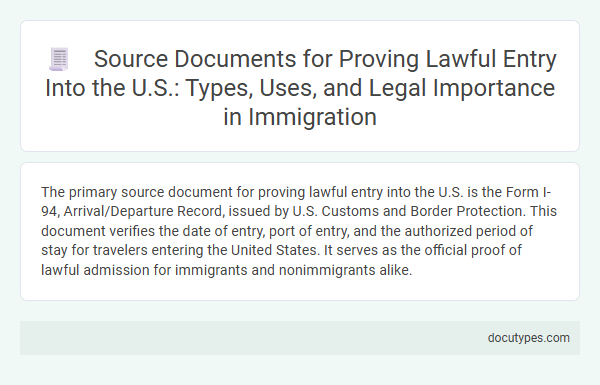The primary source document for proving lawful entry into the U.S. is the Form I-94, Arrival/Departure Record, issued by U.S. Customs and Border Protection. This document verifies the date of entry, port of entry, and the authorized period of stay for travelers entering the United States. It serves as the official proof of lawful admission for immigrants and nonimmigrants alike.
Introduction to Lawful Entry in U.S. Immigration
Lawful entry into the United States is a fundamental requirement for various immigration benefits and legal statuses. The primary source document used to prove lawful entry is the Form I-94, Arrival/Departure Record, issued by Customs and Border Protection (CBP). This document confirms an individual's authorized admission into the U.S. and is critical for immigration processes such as adjustment of status and eligibility for extension of stay.
Defining Source Documents for Lawful Entry
| Source Document for Proving Lawful Entry Into the U.S. | |
|---|---|
| Definition | A source document for lawful entry is an official government-issued record that verifies Your legal admission into the United States. This document confirms that You entered the country through authorized ports of entry under valid terms. |
| Common Source Documents |
|
| Purpose and Use | Lawful entry documents are essential for applications that require proof of legal status, including adjustment of status, visa renewals, or work authorization. They establish Your eligibility for these immigration benefits. |
| Verification | Government databases like the CBP's Arrival and Departure Information System (ADIS) store electronic records linked to source documents. |
Common Types of Lawful Entry Documents
The source document for proving lawful entry into the U.S. typically refers to official immigration documents issued by the Department of Homeland Security or U.S. Customs and Border Protection. These documents confirm that an individual has been inspected and admitted or paroled into the country legally.
Common types of lawful entry documents include Form I-94, Arrival/Departure Record, which details the date and status of entry. Another example is the U.S. visa stamped in your passport, indicating permission to enter for a specific purpose and duration.
Importance of I-94 Arrival/Departure Records
The I-94 Arrival/Departure Record serves as the primary source document for proving lawful entry into the United States. This record verifies an individual's immigration status and authorized period of stay.
- Official Proof of Entry - The I-94 form is issued by U.S. Customs and Border Protection (CBP) upon arrival and acts as the official evidence of lawful admission into the country.
- Verification of Legal Status - Employers, immigration officials, and government agencies rely on the I-94 to confirm an individual's authorized immigration status and entry date.
- Essential for Immigration Benefits - The I-94 record is critical when applying for visas, extensions, or adjustment of status as it documents lawful presence and compliance with U.S. immigration laws.
Role of Visas and Stamped Passports
The primary source document for proving lawful entry into the U.S. is your visa combined with passport stamps. These documents serve as official evidence of your authorized admission and permitted duration of stay.
- Visa - A visa is an endorsement placed in your passport by a U.S. consulate that grants permission to travel to a U.S. port of entry.
- Stamped Passport - Upon arrival, U.S. Customs and Border Protection stamps your passport, confirming the date and manner of your lawful entry.
- I-94 Arrival/Departure Record - This record, often linked with your passport and visa, formally documents your entry and authorized stay period in the U.S.
Border Crossing Cards as Proof of Entry
Border Crossing Cards serve as an official source document for proving lawful entry into the U.S. These cards are issued to Mexican nationals for short visits and function as both a visa and entry permit. When presented at the border, they provide evidence that the holder has been granted permission to enter the United States legally.
Advanced Parole and Travel Document Evidence
What is the source document for proving lawful entry into the U.S. when using Advanced Parole? Advanced Parole serves as a travel document issued by U.S. Citizenship and Immigration Services (USCIS) that permits individuals to re-enter the United States after traveling abroad without a visa. This document, accompanied by a valid I-94 arrival/departure record, acts as proof of lawful entry for parolees.
How does a Travel Document provide evidence of lawful entry into the U.S.? Travel Documents, including Refugee Travel Documents and Advance Parole, authenticate a non-citizen's authorized admission or parole into the United States. These documents, combined with USCIS arrival records, are recognized as official sources verifying lawful entry for immigration purposes.
Legal Uses of Entry Documents in Immigration Cases
The source document for proving lawful entry into the U.S. is typically the Form I-94, Arrival/Departure Record, issued by U.S. Customs and Border Protection. This document serves as official evidence of your admission, parole, or lawful status at the port of entry.
- Verification of Legal Status - The I-94 confirms the date and manner of lawful entry, essential for immigration petitions and applications.
- Eligibility for Benefits - Immigration benefits like adjustment of status or employment authorization rely on proof of lawful entry.
- Enforcement and Removal Proceedings - Entry documents are reviewed to determine an individual's legal presence or grounds for removal.
Proper presentation of your entry documentation supports your case and ensures compliance with U.S. immigration laws.
Consequences of Missing or Invalid Entry Records
The primary source document for proving lawful entry into the U.S. is the Form I-94, Arrival/Departure Record, issued by U.S. Customs and Border Protection. This document verifies the date and port of entry, essential for maintaining legal immigration status.
Missing or invalid entry records can lead to complications such as difficulties in proving authorized stay or eligibility for immigration benefits. Without valid evidence of lawful entry, You may face delays, denial of applications, or removal proceedings.
What Is the Source Document for Proving Lawful Entry Into the U.S.? Infographic

